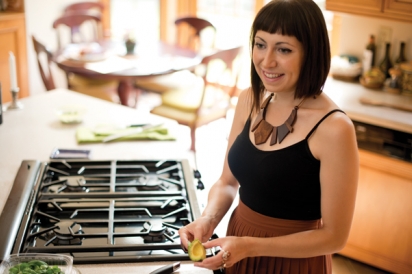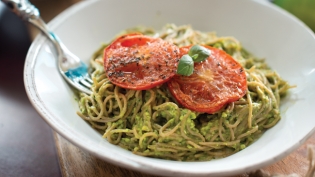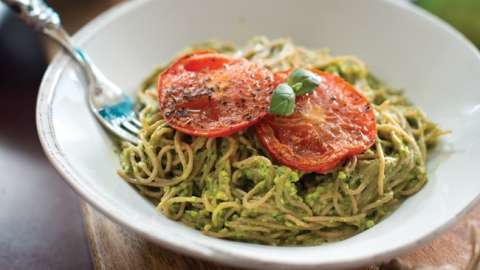Reclaim Your Kitchen
When people ask me how I lost more than 80 pounds and kept it off, they aren’t expecting what has become the only answer I find truthful: “By cooking.” Although weight loss and becoming healthy as a whole requires a countless number of efforts, cooking for myself was by far the most transformative — for my weight, my health, and my happiness.
As an obese, unhealthy young adult, I lived in the American food system, saturated with misleading traditions of “wholesome” food, a culture of over-indulgence, and the voices of the industrialized food system. Without much thought, I ate more because it was available. I ate poorly because it was satisfying. Over time, I turned down almost all meals prepared by my mother in exchange for fast food. Gas station made-to-order sandwiches. By the time I got to college, eating was completely removed from the sensation of hunger, and was instead a lustful relationship with sugar, salt, and fat. My memories of food, which I believe much of my generation can identify with, were built less from tradition and more from addiction. I was disconnected with my food, its source, and its nutrition.
The ever-enigmatic answer to weight loss seemed to be hidden behind a smoke screen of diet books, meal plans, rules, and science. Anyone who has tried to lose weight has inevitably felt frustrated with an endless, and contradictory, stream of fad diets — with reason. There is no way to keep up with“new” health science, and consequently, new product marketing. But the answer to weight loss isn’t that complicated. Eating healthy starts by simply being connected to your food — having awareness.
At age 21, I was afforded the opportunity to travel the world on Semester at Sea. When I returned home 30 pounds lighter, there was no going back. The following two years involved arduous sifting through “good” and “bad” food, failed attempts at vegetable stir-fries, and endless web searches for chain restaurants’ nutrition facts. Eventually, I learned that cooking at home gave me the most control over my calorie intake. But without any real experience in the kitchen, I had to start small — veggie wraps and steamed broccoli. I actually had to learn how to steam broccoli, which reveals a sad state of affairs. I forged ahead, soggy burritos in tow, and embraced the task of preparing healthy food. I got better and better at navigating the labyrinth of nutrition labels and ingredients lists. I found myself shocked at how complicated understanding my food had become.
Knowing where our food comes from, and how it was made, has become an increasingly difficult task over the past 40 years. Almost without notice, brick by brick, a wall has been constructed between the food on our plate and the farm, factory, or lab that it comes from. To trace the origin of many common foods has taken lengthy research by journalists and documentarists. A single fast food hamburger patty could reportedly come from dozens, or even hundreds of cows. The soft drink alongside that burger is derived from unlikely substances ranging from corn to ammonia. And, even when the chain from your food to its source isn’t quite that elaborate, someone else is still often doing our cooking for us, be it a chef or a corporation.
“We have to think about where we’re cooking and what we’re cooking,” says Alice Julier, Ph.D., program director and associate professor of Chatham University’s Food Studies Program. “With the rise of industrial, commercial production, you may not be cooking your food, but there are people cooking it.”
Technically, General Mills, for example, is cooking for you. Which isn’t always a bad thing. If I’ve learned anything in my journey to define what is healthy, it’s that you can’t generalize; not all processed foods are “bad,” as Julier is quick to emphasize. “Standardization and commercial production have, in fact, protected us from certain kinds of diseases and illness. There are levels of food safety and availability that came with processed foods. I don’t want to portray it as if people were duped [by the food industry], but rather, it was something that was taken for granted alongside other processes.”
Ultimately, we began to take for granted the control that our own preparation gave us over our health, as some methods of processing foods, corn in particular, have proven to be more harmful than helpful. High fructose corn syrup has become a widely prevalent source of added sugar in everything from salad dressings to bread. So, as these new methods of processing foods have more dubious, and portion size has increased dramatically, we may find ourselves consuming many more calories than we may have intended. Even if we have been careful what processed foods we choose to eat at home, when we dine out frequently, we forfeit the spatula to someone else.
“At home, you’ve got absolute control,” says Mim Seidel, community-based education and internship coordinator at Chatham University’s Food Studies Department. “Pasta from a restaurant and pasta at home can be extremely different in calories because of what’s added and because of the amount. You know how much oil you put in the pot, how much salt you put in, and if you are health-conscious, you can limit those amounts.”
Judy Dodd, registered dietitian with the University of Pittsburgh’s School of Health and Rehabilitation Sciences, agrees. “I have no problem with fat, or sugar. But I want to decide how much I use.”
But Seidel and Dodd aren’t bashing restaurants. “I don’t want to come down on restaurants,” Seidel emphasizes. A trend of eating more meals outside of one’s home is not inherently bad. Restaurants, particularly in Pittsburgh, provide a beautiful variety of cuisines, cultures, and flavors that are invaluable to this city’s personality. Some of them cradle old culinary traditions, like pierogies and borscht, and inspire an embrace of those connections. Restaurants with a commitment to preparing locally sourced foods, such as Habitat and Restaurant Echo, actually provide us with new ways to become aware of our food and connect to its source. The issue is not the restaurants, it’s the frequency with which we eat out. Americans dine out an average of 5 times a week, and it’s more likely fast food or fast casual dining. This means we’re constantly consuming larger-than-average portions. “Portion size since the 1950s has astronomically increased,” Seidel explains.
When did we lose control of our food? When did cooking become so uncommon? There is no definite answer, but our ways of eating have changed more in the past 100 years than they ever have in human history. Most experts I spoke with see the trend of cooking less as a result of women entering the workforce, combined with the push of the industrialized food industry to step in and capitalize on their need for convenience. “It’s important to recognize that there was an incredible effort to get women to use [commercial, processed] products in the household. There was an incredible pressure to modernity, to assimilation,” says Julier. As our mothers and grandmothers adopted foods that came from the commercial marketplace, we found ourselves without a strong logic of cuisine or culture for cooking. We grew up, like I did, without the knowledge of how to steam broccoli.
Although it seems to paint a dim portrait of younger generations lacking cooking skills and a connection to food, we also have the opportunity to re-write the rules, to be freed of constraints, and embark on cooking and sharing meals in our own, radical ways. The DIY movement is rapidly growing in Pittsburgh, and young people, in particular, are the ones invested in the food movement. Pittsburgh both cradles a resilience of food traditions deriving from places like Eastern Europe, and acts as an incubator for community dinners, potlucks, food trucks, and countless other ways we’ve devised to cook food and share food more intimately.
Jim Shones, chef and prepared foods team leader at Whole Foods Market Pittsburgh, finds it easy to explain why we are craving a return to connecting with our food. “Part of being human is being able to work with food. When you have people at a table, and you’ve cooked a meal, they might not say it, but they feel it. It’s a communion.”
Being able to share the experience of cooking a meal — something that is more than the sum of its parts — is worth reclaiming. There is satisfaction in having consciousness of everything involved in the food that you are eating and sharing it with others. “I want to be able to know the animals are raised with some mindfulness behind it,” Jim says. “To me, that means a lot. When you sit down to eat it with your family, you’re thankful for having it on your plate. ‘I am alive, I am eating, and I am alive because of this.’ It is a stronger connection, that now we take for granted.”
Not only did cooking for myself prove to give me control over my health, but it opened up an opportunity to engage in something much more than just food on a plate. In a world where screens dominate our daily lives, the act of focusing on working with your hands is truly a meditative process. It allowed me the opportunity to find satisfaction in sharing it with others, no matter how simple the “meal.”
GET COOKING
It’s not as scary as you think. Dodd encourages everyone to use simple ingredients, minimally processed foods, and do it without fear. Even if “cooking” for you is simply adding fresh vegetables to store-bought soup, that’s a start. Shones suggests taking advantage of all the helpful cooking shortcuts available at Whole Foods Market, such as pre-cut veggies, prepared sauces, or a side dish from the prepared foods department. “You’re not doing all the legwork, but you’re
still participating in the cooking process,” he says. My suggestion? Start by roping a friend, boyfriend, girlfriend, mother, or roommate into cooking with you once a week. Plan ahead, and keep it simple. It doesn’t have to be low-fat, low-carb, or even that healthy, it just has to be one step on the path to connecting with your food.
THE STARTER KITCHEN
With these five basic ingredients, you can do a lot of cooking:
Oregano
Basil
Fresh garlic
Vidalia onions
Cinnamon (Don’t just think of cinnamon as a companion for sweet foods — it brings out a beautiful natural sweetness in vegetables like carrots and squash!)
If you like spice:
Cumin
Chili powder








